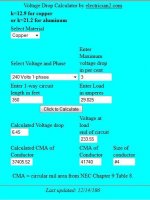il19z8rn4li1
Member
Hello friends.
Ran into an opportunity to where i can have a decent sized
LED grow op, but the issue is getting power to the location.
I need to run a wire under ground in conduit about... 300-325 feet.
Ill be running roughly 2000 watters of lighting.
500 watts of AC
400 watts of FANs
and maybe another 250 watts miscellaneous
so thats 3150, lets round that up to 3200 then figure out what
that is 80% of...
3200 / 80% = 3937.5 watts.
Lets round that up again to 4100 watts is roughly the TOTAL
wattage i need.
What my concerns are is the more detailed math involved in this calculation, namely the voltage drop on such a far run... 300+ feet.
So what i ask of the electrical gurus at this amazing place is this.
With what info I have given, can anyone that deals with this stuff
on the daily over look this for me and give me what kinda wire ill
need to purchase for this adventure
Thanks so much.
Ran into an opportunity to where i can have a decent sized
LED grow op, but the issue is getting power to the location.
I need to run a wire under ground in conduit about... 300-325 feet.
Ill be running roughly 2000 watters of lighting.
500 watts of AC
400 watts of FANs
and maybe another 250 watts miscellaneous
so thats 3150, lets round that up to 3200 then figure out what
that is 80% of...
3200 / 80% = 3937.5 watts.
Lets round that up again to 4100 watts is roughly the TOTAL
wattage i need.
What my concerns are is the more detailed math involved in this calculation, namely the voltage drop on such a far run... 300+ feet.
So what i ask of the electrical gurus at this amazing place is this.
With what info I have given, can anyone that deals with this stuff
on the daily over look this for me and give me what kinda wire ill
need to purchase for this adventure
Thanks so much.



